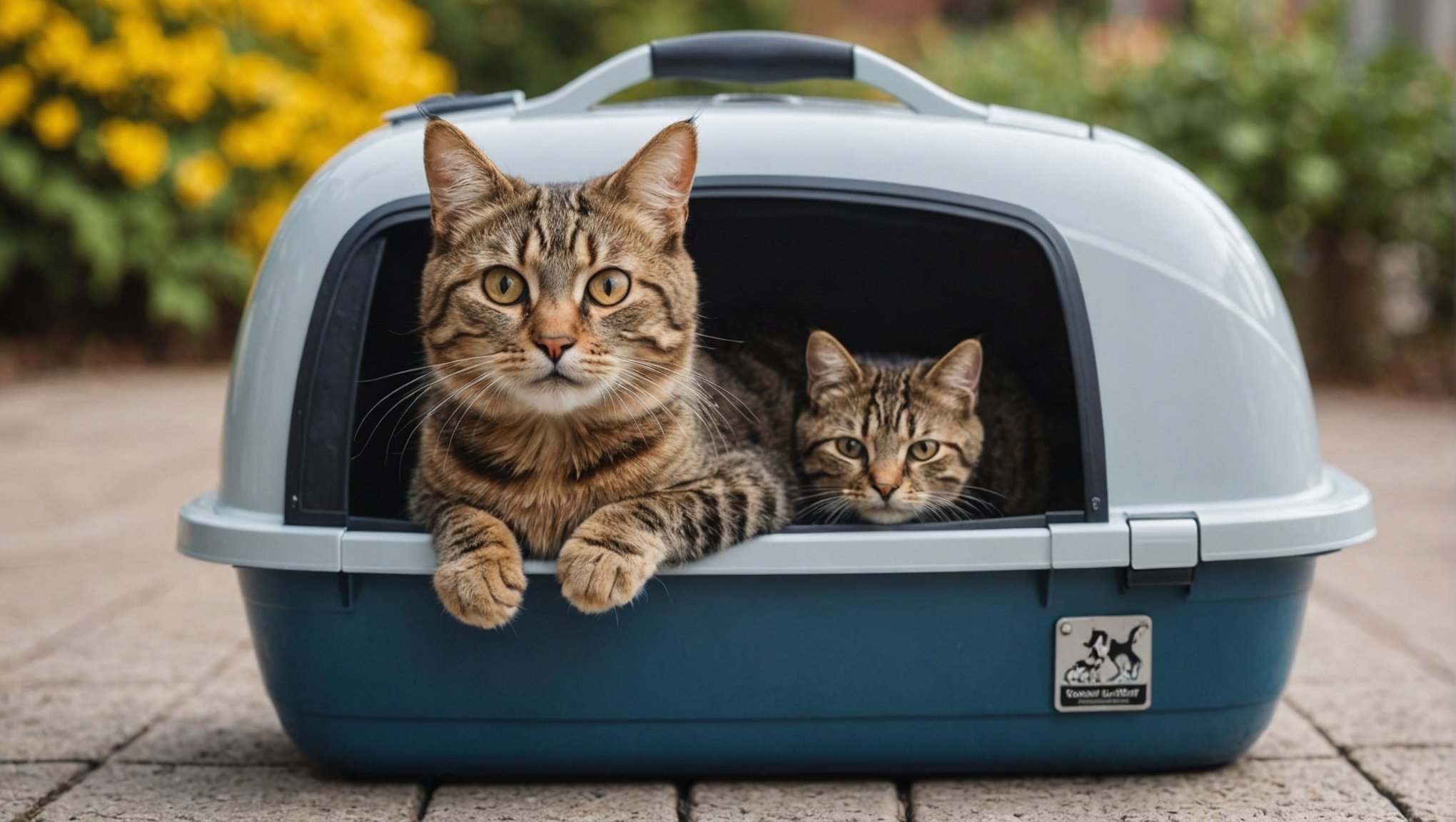Vet trips can be stressful for both you and your cat, making the right carrier essential. A well-chosen cat carrier accommodates your pet’s size and personality, ensuring comfort during travel. Consider factors like ease of use, ventilation, and security. This guide helps you navigate the options, providing tailored recommendations that align with your cat’s unique traits. Discover how to transform travel time into a positive experience for you both!
Understanding Cat Carriers
When it comes to cat carriers, selecting the right type can make a world of difference for both you and your feline friend. There are three main types: hard-sided, soft-sided, and backpack carriers. Each offers unique benefits and drawbacks depending on the situation.
A voir aussi : Mastering Clicker Training: Seamlessly Incorporate It into Your Cat”s Daily Life for Positive Behavior Changes
Types of Carriers
- Hard-sided carriers: These are sturdy and provide excellent protection. Ideal for vet visits, they ensure your cat remains safe during transport. However, they can be bulky and less comfortable for longer journeys.
- Soft-sided carriers: Lightweight and easy to carry, these are perfect for short trips or air travel. They’re more comfortable for your cat but offer less protection than hard-sided options.
- Backpack carriers: Great for adventures, they allow you to carry your cat hands-free. While convenient for hiking or casual outings, they may not be suitable for longer trips due to limited space.
Choosing a Cat Carrier
When choosing a cat carrier, consider key features such as ventilation, size, and security. Look for carriers with multiple entry points and secure closures. A well-ventilated carrier ensures your cat stays cool and comfortable. Always choose a size that allows your cat to stand, turn around, and lie down comfortably.
Determining the Right Size for Your Cat
Choosing the right cat carrier size is crucial for your pet’s comfort and safety. Start by measuring your cat from the tip of the nose to the base of the tail and from the top of the head to the ground. This ensures the carrier is spacious enough for your cat to move comfortably.
A lire également : Creating a Cat-Friendly Haven: Essential Tips for Safely Assisting Your Feline in Recovery from Orthopedic Surgery
Guidelines for Measuring Your Cat
To find the perfect fit, add a few inches to your measurements. This extra space allows your cat to stand, turn, and lie down without feeling cramped. Remember, a well-fitted carrier reduces stress during travel.
Movement and Comfort
Cats need room to stretch and adjust their position. A carrier that’s too small can lead to anxiety and discomfort. A snug fit, however, helps your cat feel secure. Ensure the carrier’s interior is padded for added comfort.
Size Specifications for Breeds
Different breeds and personalities require different carrier sizes. Larger breeds like Maine Coons may need more space, while smaller breeds such as Siamese might fit comfortably in a standard carrier. Always consider your cat’s unique personality and preferences when selecting a carrier size. This ensures a pleasant experience for both you and your feline friend.
Behavioural Considerations in Carrier Selection
Understanding your cat’s behaviour is crucial when selecting a carrier. Cats, like humans, have distinct personality traits that influence their comfort levels in different environments. Some cats are naturally curious and adventurous, while others may be more reserved or anxious. Identifying these traits will help in accommodating your cat’s needs.
Personality and Anxiety Levels
Cats with high anxiety levels may require a carrier that provides a sense of security. For these cats, a carrier with enclosed sides can offer a comforting retreat. Conversely, more confident cats might enjoy carriers with mesh panels that allow them to observe their surroundings.
Choosing the Right Carrier
When accommodating cats, consider how your cat reacts to new situations. A cat that is easily stressed might benefit from a familiar-smelling blanket inside the carrier. This can soothe nerves and make the experience more pleasant.
Introducing the Carrier
Introducing the carrier gradually can help skittish cats become accustomed to it. Leave the carrier open in a familiar space and place treats or toys inside. This encourages exploration and helps associate the carrier with positive experiences. Patience is key when easing a cat into using a new carrier.
Safety Features to Consider
When selecting a cat carrier, prioritising safety is paramount. A secure carrier ensures peace of mind during travel, keeping your feline friend safe and comfortable.
Essential Safety Features
Look for carriers with robust safety features such as secure closures and escape-proof designs. A reliable carrier should have strong zippers or latches that prevent accidental openings. Additionally, carriers with reinforced seams and durable materials offer enhanced protection.
Ventilation and Design
Proper ventilation is crucial for your cat’s well-being. Ensure the carrier has multiple ventilation points to maintain airflow and prevent overheating. Mesh panels or ventilation holes allow your cat to breathe easily while also providing visibility, which can help reduce anxiety.
Recommendations for Safety
Consider carriers that prioritise safety without compromising on comfort. Brands known for their secure carriers often incorporate innovative safety features, such as locking mechanisms and padded interiors. These additions not only keep your cat safe but also make the journey more pleasant. Always choose a carrier that suits your cat’s size and personality, ensuring a secure and enjoyable travel experience.
Acclimating Your Cat to the Carrier
Acclimating cats to a new carrier can be a smooth process with the right approach. Carrier training involves patience and understanding, allowing your feline friend to feel secure and comfortable.
Step-by-Step Guide
- Introduce the Carrier: Place the carrier in a familiar space, leaving the door open. Allow your cat to explore it at their own pace.
- Positive Reinforcement: Use treats and toys to create a positive association with the carrier. Reward your cat each time they show interest or enter the carrier.
- Gradual Introduction: Start by encouraging short stays inside the carrier. Gradually increase the duration as your cat becomes more comfortable.
Positive Reinforcement Techniques
Positive reinforcement is key to successful acclimation. Use your cat’s favourite treats or toys as a reward system. This encourages them to view the carrier as a safe and enjoyable space. Consistency in rewarding positive behaviour helps build trust and reduces anxiety.
Preparing for Vet Visits or Travel
Before vet visits or travel, ensure your cat is accustomed to the carrier. Practice short car rides to familiarise them with the experience. This preparation helps minimise stress and makes future journeys more pleasant for both you and your pet.
Product Recommendations and Buyer’s Guide
When selecting the best cat carriers, it’s important to consider various needs and budgets. Here’s a look at some top recommendations and a helpful buying guide.
Top Recommended Cat Carriers
- Petmate Two-Door Top Load Carrier: Known for its sturdy design, this carrier is ideal for those seeking durability and easy access. It features a top-loading door, making it convenient for placing your cat inside, especially for vet visits.
- Sherpa Original Deluxe Carrier: Perfect for air travel, this soft-sided carrier is lightweight and airline-approved. Its mesh panels ensure proper ventilation, keeping your cat comfortable during flights.
- Pecute Expandable Cat Backpack: For adventurous cat owners, this backpack carrier offers hands-free convenience and expandable space. It’s great for hiking and outdoor activities, providing both comfort and security.
Buyer’s Guide
When choosing a carrier, consider factors such as durability, ventilation, and ease of cleaning. Compare features across popular brands to find the best fit for your cat’s size and personality. Always check product reviews for insights on real-world performance and reliability. Prioritising these aspects will help you make an informed purchasing decision.
Addressing Common Concerns and FAQs
Travelling with cats can be daunting, but with the right cat travel tips, it becomes manageable. Owners often worry about their pet’s comfort and anxiety during trips. To ease these concerns, it’s crucial to familiarise your cat with the carrier well before any travel. Place the carrier in a common area and let your cat explore it at their own pace.
Common Concerns
Many cat owners express anxiety about vet visits. Cats are creatures of habit, and new environments can be stressful. To mitigate this, incorporate short practice trips to help your cat acclimate to the car and carrier. This reduces stress during actual vet visits.
FAQs and Practical Advice
How can I make vet visits less stressful for my cat? Use familiar-smelling items, like a blanket, inside the carrier to comfort your cat. Ensure the carrier is well-ventilated and secure.
What are some effective cat travel tips? Plan your journey, allowing for breaks if it’s a long trip. Keep the car temperature comfortable and avoid loud music.
By addressing these concerns and following practical advice, travelling with cats becomes a more pleasant experience.
















